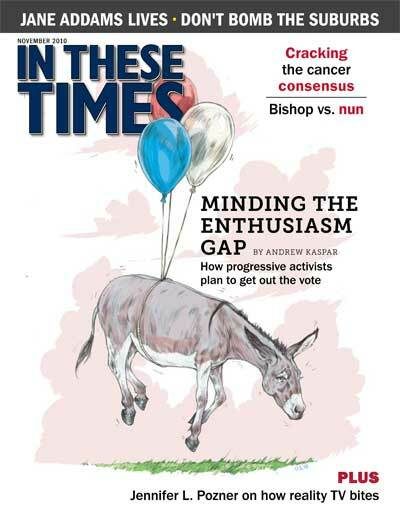Minding the Enthusiasm Gap
How progressive activists are working to get out the midterm vote.
Andrew Kaspar

Less than a month before the November 2 midterm elections, pundits and pollsters are predicting the demise of the Democratic majorities in the House and Senate. The post-Great Recession economy still suffers from about 10 percent unemployment, and an unhappy electorate is expected to “throw the bums out” – or so the conventional wisdom goes. Both parties typically look to their base for midterm victories, when turnout is historically lower than elections involving a presidential race. So it is little wonder that the media, political operatives and gleeful Republicans have harped on an “enthusiasm gap” between Democratic and Republican voters as a sure sign that this year’s elections will deal a devastating blow to the party in power.
A Gallup poll taken in late September found that 48 percent of Republicans were “very enthusiastic” about voting in this year’s elections, compared to just 28 percent of Democrats. Gallup first began gauging voter enthusiasm along partisan lines in 1994.
But an unenthusiastic Democrat is still a Democrat. And given Republicans’ threats to shut down the government, repeal healthcare reform and stymie other White House attempts to right the wrongs of the previous administration, disaffected Democrats ought to be able to give a less-than-ringing endorsement to the ruling party this November. Or so some progressive grassroots organizations hope, as they gear up for get-out-the-vote efforts in the face of tough political headwinds this fall.
The malaise of many Democrats seems to have caught the attention of the White House. At a late September fundraiser, Vice President Joe Biden instructed Democratic activists to “remind our base constituency to stop whining and get out there and look at the alternatives. This President has done an incredible job. He’s kept his promises.”
The ubiquity and ambiguity of polls
While there has been no shortage of media commentary and analysis focused on the enthusiasm gap, various public opinion polls leading up to the midterms have offered less clear-cut indicators of what November 2 will bring. A New York Times/CBS News poll conducted Sept. 10-14 offered a muddled picture of how the electorate is feeling. Almost 80 percent of Americans thought it was “time for new people” to represent them in Congress, but when asked how they feel about the two parties in general, 45 percent indicated a favorable opinion of the Democratic Party, compared to 34 percent favorable toward the GOP. At the same time in 1994 – a midterm year marked by huge gains for the Republican Party following the first two years of President Bill Clinton’s administration – Republicans were viewed favorably by 54 percent of the electorate.
Democrats also held the edge over Republicans on how representatives in Congress are doing their job (30 percent “approve” of Democrats to just 20 percent Republican approval), which party has better ideas for solving the nation’s problems (40 percent to 33 percent) and is likely to create new jobs (44 percent to 38 percent).
But polls mean little if such sentiments don’t translate to the ballot box. That’s the gap the Democratic establishment is concerned with – and voter turnout in this year’s primaries makes its worry understandable. According to the Center for the Study of the American Electorate, Republican primary participation exceeded that of Democrats for the first time since the 1930s, and overall 4 million more Republicans weighed in on their party’s general election candidate than did Democrats.
Jim Dean, chairman of Democracy for America (DFA), says at times the White House’s “incumbency protection program” has demotivated the base, as in Arkansas, where the establishment backed Sen. Blanche Lincoln over progressive favorite Bill Halter, the state’s lieutenant governor. Though DFA lost that primary battle, Dean’s generally optimistic view of the electoral landscape takes a quality-over-quantity approach.
“In the Senate, even though we’re going to have fewer seats, we’re going to have a far better quality caucus without Blanche Lincoln,” he says.
DFA holds “night school” classes online, where Dean says anywhere from 700 to 2,000 progressives log on weekly to get tips on grassroots organizing strategy. Recent weeks’ messages have included “Mobilizing Key Constituencies,” “Mobilizing Progressives with Google” and “Getting Out the Progressive Vote.”
“I’m not sure what the voter turnout is going to be,” Dean admits. “But it certainly won’t be for lack of people who are out there trying to get those votes out.”
The only thing we have to fear
Obama’s 2008 presidential campaign generated unparalleled excitement for many, including millions new to electoral politics. His message of Hope and Change resonated with young people and members of minority groups, who turned out in record numbers and are largely credited with turning candidate Obama into President Obama.
Two years later, the economy is the top issue for voters, and minorities and young people are disproportionately suffering from the nation’s unemployment woes. Young people are unemployed at more than double the national average of 9.6 percent, and as of August, African Americans suffer from a 16.3 percent unemployment rate. And that does not include the millions without jobs who have given up looking for work. Consequently, ginning up enthusiasm for the Democrats responsible for turning lofty campaign rhetoric into statutory specifics – or in the Senate’s case, crafting bills destined to be watered down or killed by arcane procedural dithering – is no easy task for organizers attempting to get out the vote.
Amy Showalter, president of The Showalter Group, a consulting firm for organizations looking to increase their grassroots effectiveness, says organizers need to “re-educate” these segments of the electorate. “Many of the folks who were really active in 2008 – not all of them, but those new voters – they want that immediate gratification,” she says. “They’re not the political pros, the people that have been doing this a long time.”
According to Showalter, organizers on the left have failed to put the last two years in perspective. “Among these new populations, what any group has to remind them of is that, ‘It’s different now. And votes have consequences and elections have consequences, and it’s a long-term process, but look at all the things we’ve been able to do because of your vote in 2008.’ “
Andrew Levine, a senior fellow at the Institute of Policy Studies in Washington, D.C, says enthusiasm may need to be augmented by fear to stem the tide of Republican gains. “Enthusiasm isn’t the issue, because voting doesn’t register enthusiasm or preference intensity or anything like that; the idea is just turnout. At least in cases where there’s a chance that voting could affect the outcome, and where there’s something to vote against, that might be enough to get turnout.”
Levine says his congressman, Rep. Frank Kratovil (D-Md.), is “awful” for opposing “even mildly progressive Obama legislation.” But if control of the House looks like it will come down to a few seats as the election nears, his preference for Democratic leadership and the thought of a potential Speaker of the House John Boehner will be enough to motivate him to vote for an “awful” incumbent.
On the right, fear has long been employed to win votes. Casting Democrats as “soft on terrorism” and proponents of “creeping socialism” is a familiar part of the GOP playbook. Such fear-based propaganda allows Tea Partiers and Republicans to claim Democrats threaten “freedom” and “traditional American values.” “Fear is definitely a motivator, particularly when loss is involved, and particularly among people of higher incomes,” says Showalter.
With Obama and his veto pen making a midterm strategy based on what Republicans “might do” irrelevant, Democrats are left to appeal to voters’ fears only in the context of what Republicans “won’t do” for the American people. Such appeals yield less visceral reactions and concurrently, a less enthusiastic base.
Organizing for whom?
The grassroots campaign apparatus that was responsible for mobilizing millions of first-time voters in support of Obama’s White House run was renamed and re-affiliated in January 2009; Obama for America became Organizing for America, and the 13 million-plus e-mail list and all other aspects of the organization were, in essence, gifted to the Democratic National Committee.
The transition and organizational makeover presented challenges. The new OFA is viewed by some activists as a top-down, White House-agenda-pushing reincarnation of a formerly grassroots organizing force.
Bob Miller, chairman of Harbor Country Progress (HCP), a Democratic Party club in southwestern Michigan’s largely rural 6th congressional district, describes being “somewhat disappointed in OFA.”
In the summer of 2009, OFA organizers were pushing support for a healthcare reform bill that didn’t include a public option or single-payer provision, something Miller’s organization and most progressives nationwide favored. Miller felt an outreach campaign to educate voters on exactly what such provisions meant would swing public opinion in their favor; local phone banking that HCP conducted using the voter education-based model found overwhelming support for the provisions, he said. But OFA opted for outreach that used only vague questions about support for the president’s plan, with little on specifics such as whether to include the ultimately doomed public option/single payer provisions.
“We know for sure that politically engaged people last year, on our side, all wanted single-payer health care,” Miller says. “We at least wanted it in the debate, and Obama and OFA were seeing to it that it wasn’t in the debate, very deliberately. So we’re not exactly unfriendly to OFA or the DNC, but we don’t find ourselves working with them at all anymore.”
Instead of devoting time and resources to congressional races, HCP is focused on supporting progressives for the state legislature – Miller personally recruited one candidate from HCP’s ranks – and gubernatorial candidate Virgil Bernero, the Democratic mayor of Lansing. HCP endorsed Bernero early in the primary race, and the Democratic Party of Michigan later contracted out the statewide distribution of Bernero yard signs to HCP, a club that numbers some 100 active members.
Miller is not the only progressive leader “whining.” Following Biden’s comment to Democratic fundraisers, Adam Green, co-founder of the Progressive Change Campaign Committee, made his displeasure known. “We on the ‘professional left’ are busting our butt to mobilize progressive voters in 2010, picking up the ball that this White House dropped when they refused to fight for the overwhelmingly popular public option, refused to break up the big banks, and demobilized Obama voters who expected this president to at least fight for big change,” he said in an e-mail.
But regardless of whose progressive feathers have been ruffled, the administration and OFA will play an important role in determining the fate of Democratic congressional majorities and the progressive agenda. The DNC spent $17 million on its get-out-the-vote effort in 2006, a midterm year that brought big gains for Democrats in the House and Senate. In June of this year, OFA and the DNC announced that it would put $50 million toward similar operations with a goal of reaching the 15 million voters that went to the polls for the first time in 2008. With OFA staffers and volunteers in all 50 states and 435 congressional districts, this get-out-the-vote effort is “unprecedented,” according to OFA spokeswoman Lynda Tran.
“Certainly the kind of staff and financial and other resources that we’re committing to the midterm elections is something that has never before been done by the party,” she says. “And we’re optimistic that that’s going to have a big impact this fall.”
As for the opinions of Miller, Green and others, Tran insists OFA “really prides itself on being an organization that’s driven from the bottom up,” pointing to periodic volunteer surveys and local strategy sessions held across the country as proof that volunteers’ feedback is the organization’s lifeblood.
Yet she acknowledges there are challenges that the young organization with big expectations faces. “[OFA National Director] Mitch Stewart and [Deputy Director] Jeremy Bird often say that we built the plane while flying it,” she says. “And we’re certainly always trying to gather information and make sure we learn lessons from the things that we’ve been able to do and the things we’d like to do better.”
With healthcare, financial reform and an occasionally contentious primary season behind them, Laura Bonham, co-founder and deputy director of Progressive Democrats of America (PDA), is confident that PDA’s 85,000 members will be voting on November 2, regardless of whether or not they are “enthusiastic” about doing so. For her, the question is simple and the alternative unthinkable.
“As we’re taking these small steps – but they are steps – in the right direction, do we want to just go back two years and forget what happened before Obama got elected? We can’t forget what happened before Obama got elected,” Bonham says. “That’s the choice you’re making: going back or going forward.”
‘Beyond the divisiveness’
The rise of the Tea Party has accentuated perceptions of an enthusiasm gap between left and right. In the summer of 2009, raucous Tea Partiers across the country disrupted healthcare town hall meetings held by congressmen. An enormous march in Washington in September 2009 was followed a year later by Glenn Beck’s “Restoring Honor” rally, and another “9÷12 Taxpayer March” this September brought a less impressive but equally disgruntled crowd to the Capitol. Since Obama’s election, the Tea Party has held a national convention, formed a congressional caucus and influenced Republican primary battles across the nation.
The Tea Party’s penchant for embracing candidates far right of center will likely give Democrats at least one Senate seat in Delaware, and perhaps another in Nevada – seats that more moderate Republican challengers might have won. But the fact remains: The left has come nowhere close to generating the same kind of media buzz, and this assymtetry has only fed into enthusiasm gap speculation.
On October 2, One Nation Working Together – a coalition of about 500 progressive, civil rights and labor groups – tried to counter the right’s perceived monopoly on enthusiasm with a National Mall march of its own. In These Times went to press prior to the march, but the group’s Communications Director, Denise Gray-Felder, says the hope is to bring the left together “to move beyond the divisiveness and the hate” of recent months and toward concrete, progressive plans to bring jobs, quality public education and equality of opportunity to all. She says regardless of turnout, the coalition will continue to press its progressive message, including get-out-the-vote efforts ahead of Election Day, and lobbying members of Congress in pursuit of progressive legislation beyond November 2.
“Our hope is that our efforts will influence the dialogue in a big way,” she says. “And that you’ll actually see people in places you never expected, across the country, re-energized and refocused on these issues.”
The Democrats’ goal, in short, is to rouse the left to save their Asses.






